SUMMER 2025
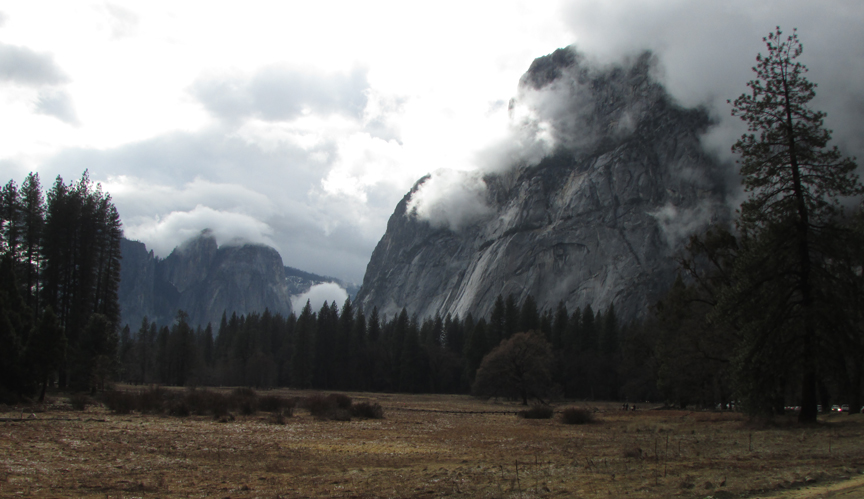
Photo from my travels: Yosemite National Park after a rainstorm
Photo by Alice Henderson
LATEST PUBLISHING NEWS
UPCOMING ALEX CARTER NOVEL!
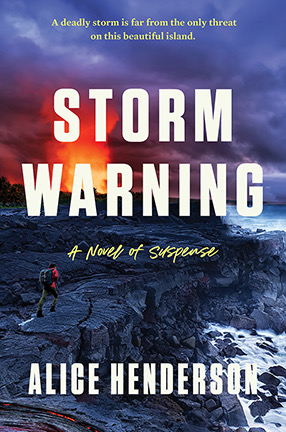
The next Alex Carter novel, Storm Warning, has been officially announced! It will be out in March 2026.
In it, wildlife biologist Alex Carter journeys to the Big Island of Hawaii to study endangered hawksbill sea turtles. But soon a hurricane develops, closing in on the island. Things worsen as armed men storm onto the beach, and Alex suspects that the intentions of these mysterious criminals extend far beyond the shores of the Big Island. Alex must scramble to protect the turtles, her friends, and the world at large…before irreversible damage is done.
It’s available now for pre-order as a hardcover, ebook, and audiobook, and will soon be added to Audible, too.
Right now, the pre-order for the hardcover is on sale on Bookshop.org, which supports local bookstores.
The pre-order for the audiobook is on sale on Google Play.
THE VANISHING KIND IS OUT AND GETTING RAVE REVIEWS
The fourth Alex Carter novel, The Vanishing Kind, is now available in hardcover, ebook, and audiobook.
In it, wildlife biologist Alex Carter encounters rugged terrain in New Mexico, threatening intruders, and mysteries surrounding an archaeological dig, all in search of elusive jaguars.

Some wonderful reviews have been coming in for it!
“A rip-roaring, satisfying yarn with plenty of environment and wildlife lore included.” –BookTrib
“Damn. Alice Henderson does it again. Fast-paced and tense, The Vanishing Kind is a perfect addition to this wonderful series. Even though it’s set in the blistering New Mexico desert, I got chills reading this incredible, nail-biting thriller. I dare you to try to put it down.” –Tara Laskowski, author of The Weekend Retreat
“Intrepid wildlife biologist Alex Carter is back….This on-the-page, ass-kicking heroine is just as cool as the real-life endangered species expert and author who writes her…and I remain a huge fan of both. Recommended for fans of page-turning thrillers infused with facts about some of the world’s most elusive and fascinating animals.” –Sara DiVello, author of Broadway Butterfly and founder/host of Mystery and Thriller Mavens
“Compelling, captivating, and compulsively page-turning. Alice Henderson is a master at drawing the reader into the rugged terrain where wildlife biologist Alex Carter finds the endangered jaguar isn’t the only one in the crosshairs. With a ripped from the headlines plot, The Vanishing Kind is environmental suspense at its finest.” — James L’Etoile, award-winning author of Face of Greed and River of Lies
It’s available from all the usual booksellers, including Barnes & Noble, Amazon, Audible, Kobo, GooglePlay, Apple Books, independent booksellers near you, and more.
WILDLIFE IN THE NEWS
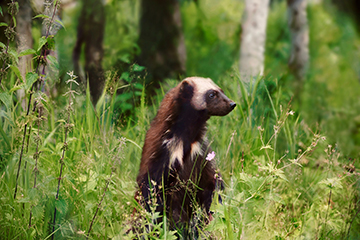
A POSSIBLE COMEBACK FOR WOLVERINES IN CALIFORNIA AND COLORADO
Recently the state legislatures of California and Colorado have proposed reintroducing the wolverine, which is in serious decline in the lower 48, with only around 300 surviving individuals.
Wolverines, which were hunted to near extinction, face numerous threats, including habitat fragmentation and due to climate change, the loss of snowpack that they rely on for denning.
Two wolverines have been spotted in recent years in California, which is part of their historical range, as is Colorado.
Excellent wolverine habitat still exists in these two states, and reintroducing these incredible creatures could provide the edge they need to save off extinction.
You can read more about this here.
Photo by Kristin O Karlsen on Unsplash
SPECIES SPOTLIGHT
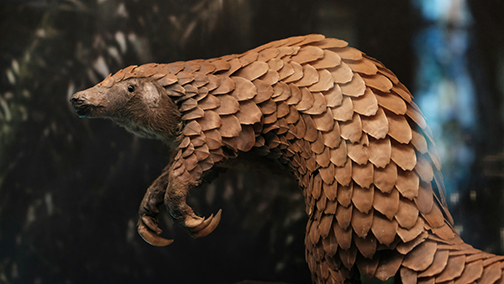
PANGOLINS
Pangolins are the only mammal on the planet covered in scales, and the earliest known fossil in their group dates back 56 million years. They are nocturnal and feed mainly on termites, ants, and other insects.
When threatened, they roll into a ball, which is where their name came from, a Malay word meaning “rolling over.”
Eight different species of pangolins exist today, yet all are in critical danger of extinction because of wildlife trafficking. In fact, they are the most trafficked mammal in the world. The Convention on International Trade in Endangered Species (CITES) banned all trade of this species in 2016, yet it still continues illegally.
To read more about pangolins and what you can do to help them, please visit the World Wildlife Fund’s information page on them here.
Photo by Studio Crevettes on Unsplash
INTERESTING WILDLIFE FACT

MOTHS NAVIGATE BY THE STARS!
A recent study in Nature revealed that endangered Australian bogong moths use the stars to navigate.
Every spring bogong moths make an epic journey of up to 1000 km to reach a series of caves in the Australian Alps. What makes this truly remarkable is that these moths have never been to this location before. They spend the summer in these cool caves and then return the 1000 km back to their breeding grounds, where they mate and pass away. Then the next generation begins the cycle again the following spring.
To find their way, the moths use the brightest parts of the Milky Way to navigate, especially focusing on the Carina Nebula. If their flight takes place over cloudy nights, the moths switch over to use the earth’s magnetic field, similar to how birds will use both the stars and magnetic field to find their way.
The bogong moth was added to the IUCN Red List of Threatened Species in 2021 due to light pollution, pesticide use, and drought.
To read more about this study, follow the link to the Nature article here.
Photo by Dns Dgn on Unsplash
GREEN TIP

TURN OFF ENERGY-CONSUMING AI
Using AI consumes a staggering amount of water and energy. When a person asks ChatGTP to write an essay for them or complete some other task, they are consuming valuable resources. But often we are using AI without even realizing it.
For example, a simple internet search will usually produce an AI answer, even if we didn’t ask for one, and often it is fraught with errors. These AI answers appear at the top of the search results, preceding accurate results from reputable sources.
But there is a very easy way to avoid it. Simply type -AI after your search words. For example, type:
What is a spotted salamander? -AI
You can type -ai in lower case letters, too. This will bring up search results that don’t include an AI-generated answer. This works in most search engines, including Google.
If you use the awesome DuckDuckGo browser, you can completely turn off AI under Settings > AI Features.
No matter which search engine you use, leaving off the AI answer will cut down the carbon footprint of your searches.
Photo by Christin Hume on Unsplash
VOLUNTEER OPPORTUNITY
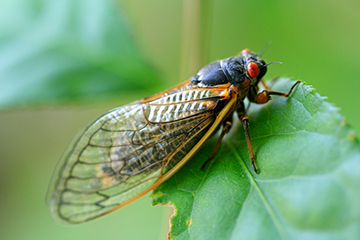
CICADA SAFARI
It’s summer and the song of cicadas is buzzing through the hot afternoons. You can help researchers better understand the distribution of periodic cicadas by contributing to Cicada Safari!
Periodic cicadas, with their signature red eyes and reddish-orange wings, differ from annual cicadas, who have black eyes and black and green bodies.
Periodic cicadas emerge in broods every 13 or 17 years depending on the species, whereas annual cicadas emerge every 2-3 with overlapping years so that there are always some annual cicadas around. In fact, there are nearly 200 kinds of annual cicadas in North America alone!
Their buzzing is created by the males, who can sing as loud as 120 decibels!
To help researchers with Cicada Safari, simply use your phone to take pictures of periodic cicadas and upload them to the free app! Spend as little or as much time as you like.
To learn more about this project, go here.
Photo of periodic cicada by Ashlee Marie on Unsplash
EXPLORING THE WORLD
AROUND US
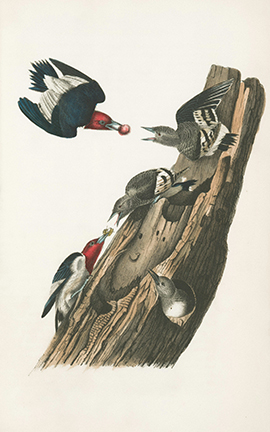
PHENOLOGY AND NATURE’S NOTEBOOK
Phenology is the study of cyclic phenomena in nature, such as when trees leaf out, when plants flower or fruit, or when animals migrate.
Studying these cycles yourself is a great way to really be in touch with your natural surroundings. You can record when migratory birds show up in your yard, or when wildflowers first appear along a favorite trail.
Because of climate change, the timing of phenological cycles is shifting. The time of year when things happen, such as flowers, seeds, and fruit appearing, is going out of sync with the wildlife that depends on it, like pollinators and migratory birds.
You can track phenological changes in a notebook or sketchbook, and even take part in contributing to a national database of phenological data.
Nature’s Notebook is part of the USA National Phenology Network (USA-NPN), which connects people and supports science and communication by providing data, tools, and resources. You can sign up to become a casual data collector, or even become a certified observer by undertaking an interesting and free online training course. Nature’s Notebook has campaigns you can participate in to track specific things like bats, pollinators, redbud trees, and more. Or you can join a local phenology group or just collect data on your own or with your friends and family.
I really enjoy contributing to Nature’s Notebook, and it’s a great way to really connect with the plants and animals in your area. Or you can just keep your own casual journal to keep track of seasonal changes.
To learn more, follow this link to Nature’s Notebook.
Photo by The New York Public Library on Unsplash
ASTROPHOTOGRAPHY!

I’ve been experimenting with different ways to record images taken with my deep sky telescope, including taking images with narrowband filters. Instead of recording a true color image using red, blue, and green light, using narrowband filters targets light emitted by certain gases, such as oxygen, sulfur, and hydrogen alpha. These allow the viewer to learn about the composition of nebulae.
I then use the Hubble Palette to process the images, assigning oxygen to the blue channel, sulfur to the red, and hydrogen alpha to the green. Stacked together, these images result in a striking color photograph bringing out specific features of deep sky objects.
Photo of the Rosette Nebula by Alice Henderson
Thank you for subscribing and reading, and I will see you next time!
If you would like to subscribe, unsubscribe, or change the address where you receive notification of Alice’s newsletter, please send an email to newsletter [AT] alicehenderson [DOT] com.
Copyright © 2025 by Alice Henderson. All rights reserved.
SPRING 2025
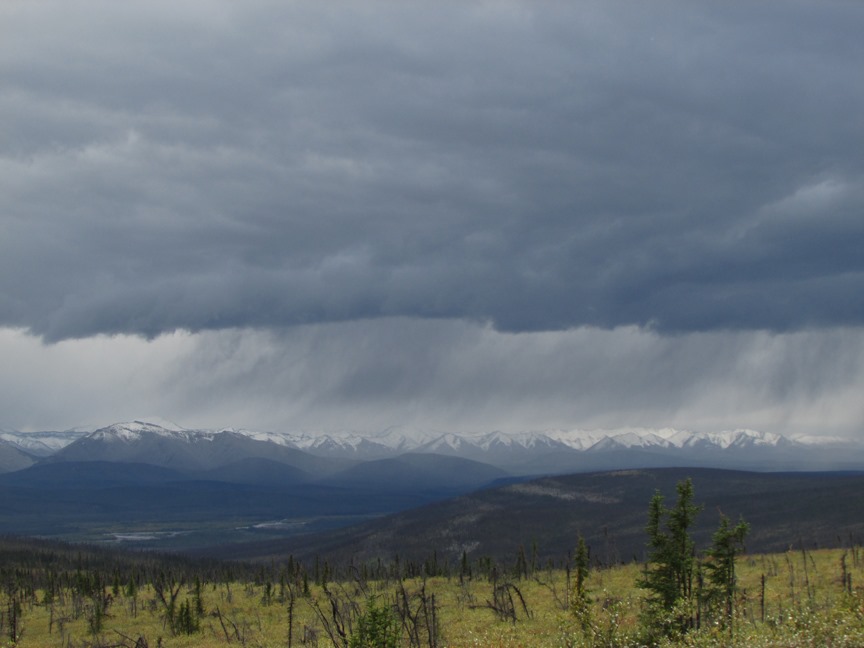
Photo from my travels: Storm over the Dempster, Yukon Territory, Canada
Photo by Alice Henderson
LATEST PUBLISHING NEWS
THE VANISHING KIND IS NOW OUT!

The fourth Alex Carter novel, The Vanishing Kind, is now available in hardcover, audiobook, and ebook!
In it, wildlife biologist Alex Carter encounters rugged terrain in New Mexico, threatening intruders, and mysteries surrounding an archaeological dig, all in search of elusive jaguars.
Available at bookstores everywhere.
A GHOST OF CARIBOU NOW OUT IN PAPERBACK
The paperback version of A Ghost of Caribou is now available, complete with an amazing new cover!
In it, wildlife biologist Alex Carter encounters an unsolved murder and a Washington state town in turmoil while in search of a majestic, all-but-vanished animal, the mountain caribou.
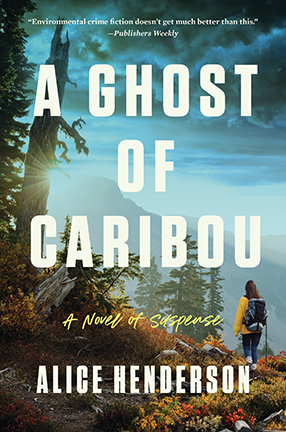
It’s available from all the usual booksellers, including Barnes & Noble, Amazon, Audible, Kobo, GooglePlay, Apple Books, independent booksellers near you, and more.
MYSTERY AND THRILLER MAVENS INTERVIEW
I was thrilled to be interviewed by talented author Sara DiVello in anticipation of the release of my latest thriller, The Vanishing Kind.
Sara is a fabulous host, and we had a blast talking about jaguars, bear encounters, wildlife conservation, and more!
You can watch the interview here.
AUTHORS ON THE AIR INTERVIEW
I very much enjoyed speaking with fellow author James L’Etoile for Authors on the Air. We discussed my latest thriller, The Vanishing Kind, as well as writing, jaguars, mountain caribou, wolverines, and creating vivid settings.

You can watch the video interview here or if you prefer an audio version, the podcast is available on all regular podcasts outlets including Soundcloud, Spotify, and Apple Podcasts.
WILDLIFE IN THE NEWS
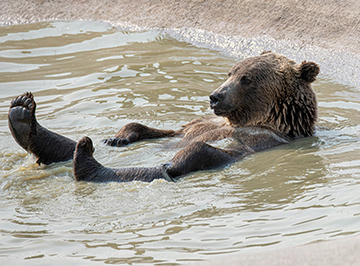
GRIZZLY BEARS WILL STAY ON ENDANGERED SPECIES ACT
Idaho, Montana, and Wyoming have sought to delist the bear, allowing management of grizzlies by the states rather than the federal government in order to allow trapping and hunting, including trophy hunting.
Because of habitat loss, fragmentation, and roads, the lack of connecting lands has led to genetic isolation for grizzlies, which leaves them vulnerable to disease and mutations. Eradication in the days before the existence of the Endangered Species Act led to the extinction of grizzlies in many states such as California, which still boasts the grizzly on their flag, despite having none who survived the onslaught.
But early this year, the U.S. Fish & Wildlife Service ruled that grizzlies will remain protected under the Endangered Species Act and recovery plans will continue to be carried out.
You can read more about this decision here.
Photo by mana5280 on Unsplash
SPECIES SPOTLIGHT
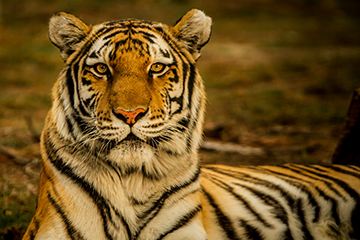
TIGERS
We can make a difference!
Large carnivores are a vital part of a healthy ecosystem. But by the early 2000s, tigers lived in less than 10% of their historical range.
But a multi-pronged approach undertaken by India has doubled the tiger population there since 2010. They created tiger reserves, habitat corridors, enacted strict anti-poaching laws, and engaged local communities in their conservation.
This shows that iconic large predators can be recovered in areas even with high human population. In fact, tigers had vanished from locations with habitat loss, armed conflict, and poverty. But setting aside land for tigers in those areas brought about land sharing and socioeconomic prosperity.
You can read more about India’s tiger recovery here.
Photo by Blake Meyer on Unsplash
INTERESTING WILDLIFE FACT
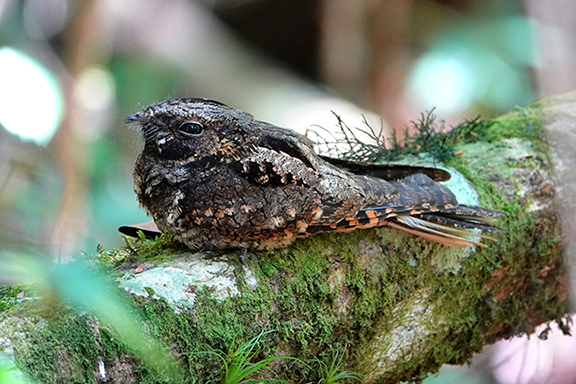
BIRDS THAT HIBERNATE?
What? There are birds who hibernate? Yes! The large black-eyed, master of disguise – the common poorwill, a member of the nightjar family!
Every year I delight to the first warbling, haunting song of the poorwills as they call from the darkened forest.
For days or even weeks at a time in cold weather, the poorwill can enter a state of torpor, lowering its heartbeat, breathing, and body temperature down to 41° F.
In fact, the Hopi name for the poorwill, hölchko, means “the sleeping one.”
If you would like to read more about this remarkable bird and hear its dreamy, warbling call, visit this page.
Photo by Nicolas Pratlong on Unsplash
GREEN TIP
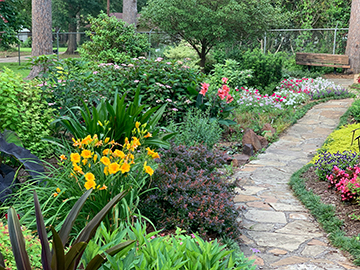
NATIVE, POLLINATOR-FRIENDLY PLANTS
As you get ready to select plants for your spring and summer gardens, please consider using native plants that are pollinator friendly. Our pollinators are not faring well due to the overuse of pesticides, habitat loss, and climate change.
But the wonderful thing about creating a space for pollinators is that it doesn’t require a lot of room and is extremely beneficial.
We may not all have huge tracts of land that we can devote to wildlife movement, but a small patch for pollinators can do wonders.
The Xerces Society for Invertebrate Conservation has an excellent Native Plant, Seed, and Service directory. Just go to this link, put in your area, and it will provide numerous sources for pollinator-friendly, native plants, including milkweed to help monarch butterflies!
Photo by Aniston Grace on Unsplash
VOLUNTEER OPPORTUNITY
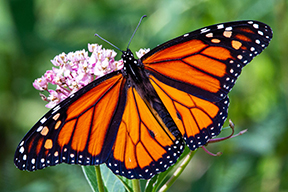
HELP MONARCHS
As spring arrives, milkweed will start to bloom, attracting imperiled monarch butterflies.
You can aid in their conservation by taking part monarch studies depending on where you live.
No matter where you live in North America, you can contribute to the Monarch Larva Monitoring Program. To learn how to get involved, go to this link.
And if you live in the western U.S., you can also contribute to the Xerces Society for Invertebrate Conservation’s Western Monarch Milkweed Mapper project. Just visit patches of milkweeds and record the location and if you see monarch adults or caterpillars.
For more information on the Milkweed Mapper project, go here.
Both projects are easy and fun and a great reason to get outside and enjoy the spring weather.
Photo by Joshua J. Cotten on Unsplash
EXPLORING THE WORLD
AROUND US

TAKING QUICK DIPS INTO LONELY BOOKS
Are you like me and have a ton of books you have gathered over the years but that you haven’t delved into in a long time?
One thing I really enjoy is making a regular practice of taking quick dips into reference books. If I have a spare moment, I’ll pull a random book off my shelf and read an interesting fact.
My bookshelves brim with a wide range of reading material — astronomy, paleontology, geology, languages, climatology, meteorology, nature guides. I’ll pull a book down and read a fact about a tree species or a particular fossil or nebula. I also love to dip into journals and letters of other writers like L.M. Montgomery and George Gissing. I can just read a quick entry and be enriched by it. I find that I get so much joy from this practice of regularly exploring my own shelves.
Do you have any textbooks left over from classes you took a while back? Or maybe poetry collections if you studied literature? Are they just gathering dust or stored away somewhere in a box? These are great sources for dipping into. Why not pull them out from time to time and read an interesting little tidbit?
It’s a great way to keep your curious mind engaged, refreshed, and learning, and also to show those books, which may be feeling neglected, some much deserved love.
Photo by Inaki Del Olmo on Unsplash
ASTROPHOTOGRAPHY!
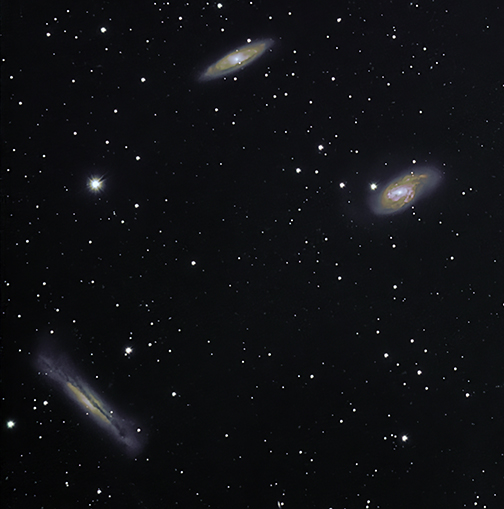
The Leo Triplet is a set of three galaxies in the constellation Leo. They lie 35 million light years away and consist of galaxies Messier 65, Messier 66, and NGC 3628, also known as the Hamburger Galaxy. They gravitationally affect one another, causing a bit of warping and deformation.
Photo by Alice Henderson
Thank you for subscribing and reading, and I will see you next time!
If you would like to subscribe, unsubscribe, or change the address where you receive notification of Alice’s newsletter, please send an email to newsletter [AT] alicehenderson [DOT] com.
Copyright © 2025 by Alice Henderson. All rights reserved.
WINTER 2024
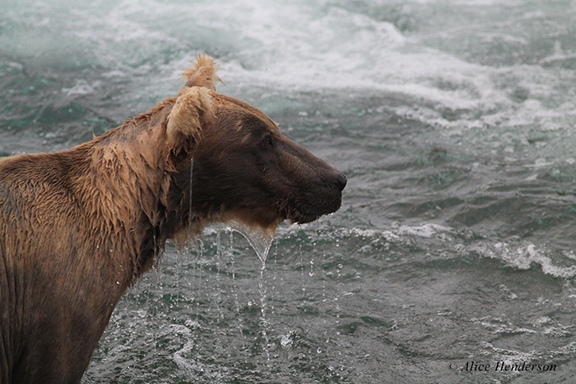
Photo from my travels: Grazer, who won Fat Bear Week 2024, in Katmai National Park, Alaska
Photo by Alice Henderson
LATEST PUBLISHING NEWS
GOOD FIGHT FRIDAYS
I had an amazing time talking with fellow writer Margaret Pinard on her Good Fight Fridays about addressing social justice, climate issues, and wildlife themes in writing.
If you missed the live talk, you can watch it at this link.
LOOKING FOR A GIFT FOR YOUR OUTDOORSY FRIEND OR FAMILY MEMBER?
The first three Alex Carter novels are available now! Journey with wildlife biologist Alex to the wilderness of Montana in A Solitude of Wolverines, or to the Canadian Arctic in A Blizzard of Polar Bears. Or venture through the interior rainforest of Washington state in search of the elusive mountain caribou in A Ghost of Caribou.
And if you’re looking for a last minute gift, all three are available as ebooks and audiobooks for immediate download or gifting!
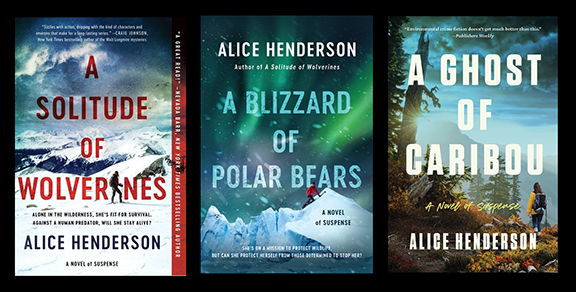
UPCOMING ALEX CARTER PAPERBACK RELEASE
The paperback version of A Ghost of Caribou will be released on February 18, 2025, complete with an amazing new cover! The audiobook, ebook, and hardcover are available now.
In it, wildlife biologist Alex Carter encounters an unsolved murder and a Washington state town in turmoil while in search of a majestic, all-but-vanished animal, the mountain caribou.

It’s available from all the usual booksellers, including Barnes & Noble, Amazon, Audible, Kobo, GooglePlay, Apple Books, independent booksellers near you, and more.
FOURTH ALEX CARTER NOVEL OUT SOON!
The fourth Alex Carter novel, The Vanishing Kind, will be released in hardcover, audiobook, and ebook on March 4, 2025! In it, wildlife biologist Alex Carter faces vigilantes and mysterious threats while tracking jaguars in New Mexico’s rugged backcountry.
It’s available from all the usual booksellers, including Barnes & Noble, Amazon, Audible, Kobo, GooglePlay, Apple Books, independent booksellers near you, and more.
WILDLIFE IN THE NEWS
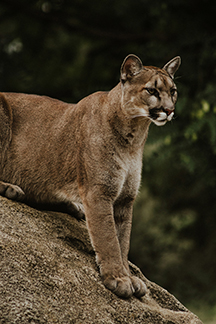
FLORIDA PANTHER POPULATION IN JEOPARDY
Only a couple hundred panthers survive in the wild in Florida, and 2024 was a particularly devastating year for them. 31 panthers died so far this year, 24 of them struck by cars.
Increased development and habitat fragmentation in Florida has also contributed to their decline.
Wildlife overpasses and underpasses are greatly needed in areas where panthers are known to cross busy roadways.
You can read more about the recent panther vehicle collisions here.
If you would like to help panthers, the Center for Biological Diversity has a great resource here.
Photo by Priscilla Du Preez on Unsplash
SPECIES SPOTLIGHT
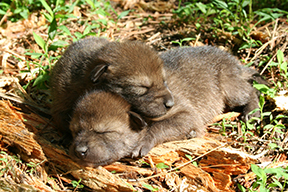
RED WOLVES
Red wolves, Canis rufus, used to roam all over the southeast United States and even up into New York. But their population has been decimated by overhunting, mismanagement, and vehicle strikes.
Now they are the most endangered wolves on the planet. Only sixteen remain in the wild today in a pocket of eastern North Carolina. The U.S. federal government still allows them to be shot and has deemed them a “nonessential” population.
SaveRedWolves.org is currently raising money to build wildlife crossings along Highway 64 in North Carolina, which would decrease wildlife fatalities from vehicle strikes by 97%. This route is frequently and increasingly traveled by motorists going to and from the Outer Banks. But the organization needs more donations to see this project built.
If you are interested in helping with this endeavor, you can read more about it here.
Photo of red wolf pups by Ryan Nordsven/ USFWS
INTERESTING WILDLIFE FACT

VAMPIRE BATS ARE FAST RUNNERS
Though we think of flying and the sky as the domain of bats, vampire bats are actually speedy racers, able to lope across a forest floor to reach prey.
Unlike other mammals, instead of burning carbs or fat to fuel their speed, vampire bats actually use amino acids from the blood they drink. And they do this quickly — in less than 10 minutes after drinking blood, a speed unequaled in other mammals.
But there’s a downside to this quick fueling method, as vampire bats don’t store much fat or carbs. They can actually starve if they go more than a day without drinking blood, so bats will help each other out by regurgitating their meals to help out bats who haven’t fed, ensuring the survival of the roost.
And how fast can these vampire bats run? They can exceed two meters per second!
You can read more about the study here.
And if you’d like to watch a vampire bat galloping along on a tiny treadmill, check out this video.
Image by OpenClipart-Vectors from Pixabay
GREEN TIP
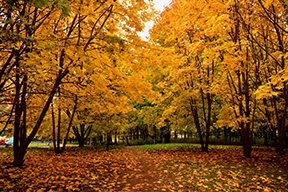
LEAVE THE LEAVES FOR WILDLIFE
Fallen leaves provide invaluable insulation, shelter, and food for a number of species including butterfly caterpillars, vital pollinating bees, turtles, toads, mammals, and more.
By leaving layers of leaves in your yard, you help these species survive through the cold winters.
And there are other environmental benefits, too. Raked leaves account for 13% of the U.S.’s solid waste in landfills. Normally leaves decompose when exposed to oxygen, but when compacted in landfills, there is not enough oxygen present and leaves instead give off methane.
Leaving the leaves means a layer of natural fertilization and will suppress weeds, a boon to gardeners.
You can read more about the benefit of leaving the leaves here.
Photo by Polina Grishma on Unsplash
VOLUNTEER OPPORTUNITY
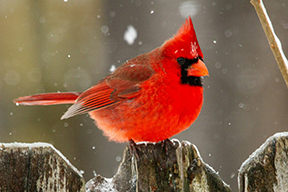
CHRISTMAS BIRD COUNT AND FEEDERWATCH
From December 14 to January 5, join the Audubon Society in collecting data on birds, a community science project that goes back 123 years!
This collected data is then used for invaluable research like population trends.
Check out this link on how to participate.
The Christmas Bird Count takes place in specific areas. If there is no count in your area, please consider participating in Cornell Lab of Ornithology and Birds Canada FeederWatch, which you can do from your own yard! You simply sign up and start counting birds, then submit your data.
The data you contribute will help researchers better understand winter bird distribution and abundance.
Click here to learn more.
Photo by Joshua J. Cotten on Unsplash
EXPLORING THE WORLD
AROUND US
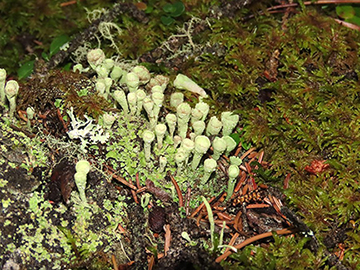
LICHEN!
Lately I’ve been delving into the world of lichen. They are fascinating lifeforms, a complex, symbiotic combination of organisms including algae, cyanobacteria, and fungi. They come in a marvelous variety of shapes and colors and occur in all kinds of habitats, from rainforests to deserts to cold places like Antarctica. They are an important food source, too, for species like caribou.
Whenever I’m out hiking, I love to explore tree bark and boulders to see what lichen species I can spot. I often bring a hand lens to observe even more of the intricate and fascinating structures and forms that lichen takes.
Here are some photos of lichen I’ve observed in the field:
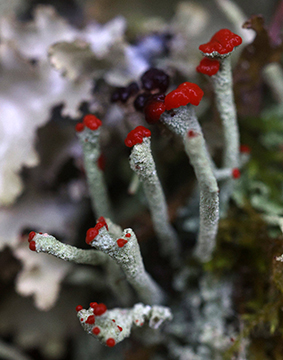
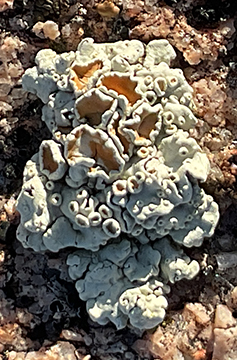
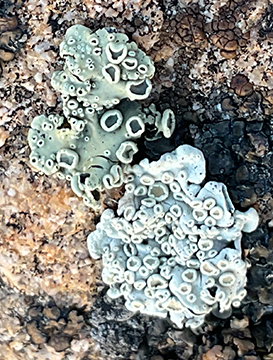
ASTROPHOTOGRAPHY!

I’ve been having an amazing time photographing deep sky objects and would like to share this image I captured of M42, the Orion Nebula.
If you don’t have a telescope, get a pair of binoculars and check out the constellation of Orion this winter. You can see the Orion Nebula around the middle star of Orion’s sword.
Photo by Alice Henderson
Thank you for subscribing and reading, and I will see you next time!
If you would like to subscribe, unsubscribe, or change the address where you receive notification of Alice’s newsletter, please send an email to newsletter [AT] alicehenderson [DOT] com.
Copyright © 2024 by Alice Henderson. All rights reserved.
SUMMER 2024

Photo from my travels: The Antelope Valley Poppy Reserve, California
Photo by Alice Henderson
LATEST PUBLISHING NEWS
COVER REVEAL FOR THE FOURTH ALEX CARTER THRILLER, THE VANISHING KIND!
Introducing the fabulous cover for Alex Carter #4, which is set in New Mexico and is about jaguars. My publisher has set the publication date to March 2025.
Much thought was given to changing the title themes, too, so instead of the working title, which was A Prowl of Jaguars, the book will be titled The Vanishing Kind.
It is currently available for pre-order on Barnes & Noble in hardcover, audiobook, and ebook, and soon all formats will be available for pre-order on Amazon, Kobo, Google Play, Apple Books, IndieBound, and others.
THE FIFTH ALEX CARTER THRILLER
I’m happy to announce that I’m at work on the fifth Alex Carter novel, and as always, am really enjoying joining Alex on her next adventure.
An official announcement will follow, revealing the title and which species I’ll be focusing on. Can’t wait to share it with you all!
IN THE MEANTIME…THE SKYFIRE SAGA!
If you’d like to read more of my work and are waiting for the next Alex Carter novel to come out, please consider checking out my climate change trilogy The Skyfire Saga, which includes the novels Shattered Roads, Shattered Lands, and Shattered Skies.



It’s full of adventure, astronomy, science, and action! In it, a menial laborer in a near future society in which science has been abandoned, learns that an asteroid is on a collision course with the earth. Can she find a fabled group of scientists who live in the weather-ravaged world beyond her climate controlled city and find a way to deflect the asteroid?
The trilogy is available in ebook, audiobook, and paperback.
AUTHOR INTERVIEW IN THE WASHINGTON INDEPENDENT REVIEW OF BOOKS
I was delighted to be interviewed by fellow writer Tara Laskowski. We talk about my Alex Carter thriller series, wildlife, conservation, and what everyone can do to help.
You can read the interview here.
AUTHOR EVENT FOR UNIVERSITY OF NORTHERN BRITISH COLUMBIA
If you missed the author talk I gave for the University of Northern British Columbia, the video is now available. It was a wonderful group of attendees and I discussed using fiction to shed light on conservation, interesting facts about the species I’ve written about thus far, and answered questions about how to fight through writer’s block and get your work out there.
You can watch the video here.
WILDLIFE IN THE NEWS

WOLVERINES GET LISTED AS THREATENED UNDER THE ESA
The U.S. Fish & Wildlife Service (USFWS) just issued a final rule listing wolverines in the lower 48 as threatened under the Endangered Species Act.
This decision has been a very long time coming, and is the result of the stalwart dedication of many nonprofit wildlife organizations who demanded that the USFWS examine the science again.
The wolverine population has plummeted due to climate change, overharvesting, and habitat fragmentation. Though they once roamed as far south as New Mexico and as far east as the Great Lakes, now fewer than 300 wolverines survive in pockets of the Cascades and Rocky Mountains.
Unfortunately, the final ruling will likely include loopholes such as the death of wolverines in traps set for other species.
You can read more about the decision here.
Photo by Kristin O Karlsen on Unsplash
SPECIES SPOTLIGHT

GRAY WOLVES
A lot of exciting things have been happening with wolves lately. Five wolves were released in Colorado late last year, the first wolves to live in that state since they were eradicated eighty years ago.
And a lone wolf, likely dispersed from the Shasta Lake pack in California, was spotted in northern Nevada, where they haven’t lived in more than a century.
But wolves still need our help. Northern Rockies wolves were removed from the Endangered Species Act, allowing states to hunt and trap them aggressively. Over 2022-2023 in Montana and Idaho alone, more than a thousand wolves were killed.
And the House of Representatives just passed a bill that will strip federal protection from most of the other wolf populations across the lower 48.
Nonprofits such as the Center for Biological Diversity, The Humane Society, the Sierra Club, and more have petitioned and sued the U.S. Fish & Wildlife Service to relist the Northern Rockies wolf population under the Endangered Species Act, but so far reinstating protections has been denied.
INTERESTING WILDLIFE FACT

WOODPECKER TONGUES
Woodpeckers have some of the longest tongues in the bird world. They use them to access deep crevices and extract beetle larvae and other tasty tidbits. But want to hear something really crazy? Their tongues are so long, up to a third of the bird’s body length, that their tongues actually wrap around their brains to cushion against the impact of their pecking.
A woodpecker’s tongue splits into a V just behind its hyoid bone in their upper beaks. The two tongue sections then wrap completely around the inside of their skulls, meeting up again as a single tongue at the base of the lower beak.
To read more about this, and see some fascinating diagrams, go to this site.
Photo of northern flicker by Alice Henderson. The northern Flicker has the longest tongue of the North American woodpeckers.
GREEN TIP

REDUCE OUTDOOR LIGHTING
Did you know that noise and lights negatively affect amphibians?
Noise can interfere with frogs’ abilities to communicate vocally with each other, and can mask the sound of approaching predators. And light can make it easier for those predators to locate frogs.
You can help by shutting off external lights (and pulling curtains to cut out indoor lights) during vulnerable breeding seasons. Installing a light with a motion sensor rather than leaving an outdoor light burning all night will help. And think about any noise that emanates from your property or community and if it can somehow be reduced.
Cities and communities can help by making sure that the light from street lamps is directed downward, rather than diffusing broadly.
These steps will also greatly benefit many other species of wildlife, too.
You can read more about this here.
Photo by David Mohseni on Unsplash
VOLUNTEER OPPORTUNITY

OBSERVE NATURE
It’s summer and a lot of wildlife is very active — finding mates, building nests, raising young. Flowers are blooming, trees are in full leaf. It’s a great time to get out in nature.
You can help researchers gather valuable data by recording your wildlife, plant, mushroom, lichen observations, and more on the iNaturalist app or at iNaturalist.org. Bird sightings can be recorded on ebird. You can use the Merlin Bird ID app, created by the Cornell Lab, to identify birds by sound and sight, and the Seek app, created by iNaturalist, to identify plant and animal species with your phone or tablet camera.
By adding your observations, you are contributing to a global database that keeps track of biodiversity and supports a host of local and international research projects.
Photo of American pika by Alice Henderson
EXPLORING THE WORLD
AROUND US


NATURE JOURNALING
Steeping in nature is always a powerful way to feel connected to our planet. From camping trips to day hikes to just sitting outside on your porch listening to birds, there are a lot of different ways to experience the out of doors.
One thing I’ve been doing for years is keep a nature journal. I write and draw in it most days, jotting down notes and sketches of the wildlife I see and hear, the kinds of trees I hike through, the lichen I find on boulders. I also record the weather that day. I’ve found that I notice so many more details when I’m journaling than I do if I’m just sitting or hiking through a particular area. As I pause to sketch a wildflower, I suddenly notice a ladybug on the petals, or notice an even smaller flower of a different species beside it.
You don’t have to consider yourself an artist to keep a nature journal. Just writing down observations and making quick little sketches for yourself is a rewarding way to get in touch with the nature around you.
If nature journaling interests you, or if you already keep one and want to brush up on your skills or meet up with other journalers, there are a variety of clubs out there that host gatherings and give tutorials. This page has a wealth of information about clubs all over the world, as well as tips about starting your own.
ASTROPHOTOGRAPHY!

I’m introducing a new section in my newsletter – astrophotography!
I’ve long been fascinated with astronomy. When I was a kid, my dad and I spent many a happy hour gazing through a telescope he had built, marveling at Jupiter, Saturn, and the moon.
I’ve now taken up astrophotography and have begun imaging deep sky objects like galaxies and nebulae. I’m excited to share the results with my readers!
The Horsehead Nebula was one of the first nebulae I learned about as a kid and have long wanted to see it through a telescope of my own. I love the little horsehead there, looking like a knight chess piece, rising above a bed of dreamy nebulosity.
Photo by Alice Henderson
Thank you for subscribing and reading, and I will see you next time!
If you would like to subscribe, unsubscribe, or change the address where you receive notification of Alice’s newsletter, please send an email to newsletter [AT] alicehenderson [DOT] com.
Copyright © 2024 by Alice Henderson. All rights reserved.
NOVEMBER 2023

Photo from my travels: Grazer, the Alaskan brown bear who won Fat Bear Week this year, sitting in the part of Brooks Falls known as “the Jacuzzi.” Katmai National Park, Alaska
Photo by Alice Henderson
LATEST PUBLISHING NEWS
TWO EVENTS FOR THE UNIVERSITY OF NORTHERN BRITISH COLUMBIA
I’m thrilled to be participating in two events through the University of Northern British Columbia. Both events are virtual and open to the public.
On Thursday, November 23, from 7 – 8 pm Pacific Time, I’ll be giving an author talk about using fiction to shed light on conservation and about my path to publication.
On Friday, November 24, from 3:30 – 4:30 pm PT, I’m very honored to be on a panel addressing different approaches to caribou conservation. West Moberley First Nations Chief Roland Willson and WMFN Elder Diane Desjarlais will discuss WMFN and Saulteau First Nations efforts to bring the Klinse-Za Caribou herd back from the edge of extinction, while creating new protected areas. Dr. Libby Ehlers will discuss the role of the ecologist in supporting conservation, and I’ll be talking about using fiction to raise public awareness.
Please join us!
Here is the Zoom link for the author talk on Thursday, Nov 23 from 7-8 pm Pacific Time: link
And here is the Zoom link for the panel on Friday at 3:30 – 4:30 pm Pacific Time: link. Passcode is 067643.
NEW FOREIGN LANGUAGE EDITION
I’m pleased to say that a new foreign language edition of my work is appearing! It’s always so neat to see a foreign language edition of a novel.
The German translation of A Ghost of Caribou, titled Still, will be out on November 21, 2023.
I’m so honored to say that over the years my fiction has been translated into German, Italian, Spanish, Turkish, and Russian.
A GHOST OF CARIBOU HARDCOVER ON SALE!
Right now you can get the gorgeous hardcover edition of A Ghost of Caribou for 50% off on Amazon.com. It is also available as an ebook and an audiobook.
You can order A Ghost of Caribou from a variety of sites:
WILDLIFE IN THE NEWS

FEDERAL BIRD-SAFE BUILDINGS ACT OF 2023
Did you know that a staggering number of birds are killed by colliding with building glass? Current estimates range from 300 million to a billion deaths each year.
But this can be prevented by using bird-friendly building materials. Right now the Federal Bird-Safe Buildings Act of 2023 has been introduced in Congress. It would promote bird-friendly practices for federal buildings.
You can read more about the Act (H.R.3781) here.
The bill is bipartisan and cost-neutral. You can urge your representative to cosponsor and support the Bird-Safe Buildings Act by using this easy form on the Audubon Society website.
Photo by Joshua J. Cotten on Unsplash
SPECIES SPOTLIGHT

LOGGERHEAD TURTLES
Loggerhead turtles are amazing, some migrating more than 7500 miles between beaches where they lay their eggs. They can weigh as much as 400 pounds and grow to be four feet in length.
But unfortunately, those migrations bring them into contact with countless fishing nets and longline hooks, endangering their lives. These commercial fishing endeavors intending to catch tuna and other fish also host a staggering number of incidental bycatches, including sea turtles, birds, marine mammals, sharks, and more. Fishing outfits can fit their nets with turtle excluder devices, or TEDs, but many do not.
Loggerheads are listed as endangered under the Endangered Species Act, but are under continual threat due to oil and gas development, climate change effects like sea level rise inundating their nesting beaches, bycatch in fishing lines, and tourism development.
To read more about them and what you can do to help, see this informative page.
INTERESTING WILDLIFE FACT

WHALES HAVE HIP BONES
You wouldn’t picture a whale having hip bones, yet they do! Their hips are a vestigial feature from when whales lived on land forty-nine million years ago and walked on four legs.
One ancient land-walking whale, Ambulocetus natans, was about twelve feet long and weighed as much as 400 pounds, with a tremendous, toothed skull.
You can read more about Ambulocetus on this page from the American Museum of Natural History.
Photo by Todd Cravens on Unsplash
GREEN TIP

AVOIDING BOTTLED WATER
Bottled water creates enormous amounts of plastic waste. It leads to 1.5 million tons of waste and requires 47 million gallons of oil to produce per year. And the vast majority of bottles are simply thrown away rather than recycled. In addition, bottled water isn’t a good value for your money and leads to the corporatization of water.
The U.S. has some of the cleanest tap water on the planet, so if you’re lucky enough to live in a place with safe tap water, consider purchasing a reusable bottle and fill it with your local tapwater instead of buying bottled water.
If you don’t like the taste of your local tap water, you can buy a filter and chill the water in the refrigerator. You’ll be saving money and being more conscientious.
You can read more about why bottled water is unnecessary here.
Photo by John Cameron on Unsplash
VOLUNTEER OPPORTUNITY

BEACH AND RIVER CLEANUPS
Speaking of plastic trash, you can help with this problem, intercepting trash before it gets into our oceans and rivers.
Plastic litter can pile up on beaches and riverbanks from regular visitor use, but also during holiday celebrations such as the Fourth of July, New Year’s Eve, and other times of the year.
This helpful site lists lake and river cleanups you can participate in.
And if there are no scheduled cleanups in your area, considering hosting your own river or beach cleanup.
This site offers a useful guide on how to organize beach cleanups.
And this page offers insights and tools for hosting a river cleanup.
In addition, you can use the Litterati app to map problematic areas where you are finding litter along our nation’s rivers. You can upload photos, arrange a cleanup, and even get your community involved.
Photo by Taylor R on Unsplash
EXPLORING THE WORLD
AROUND US

WHO’S YEHOODI?
I love old time radio from the 1930s-1940s — tales of detectives, suspense, horror, science fiction, comedy. There is pure gold to be discovered in these wonderful radio plays.
I love music from this era, too. One of my favorite songs from the 1940s is “Who’s Yehoodi?” by Kay Kyser. It never ceases to crack me up. You can listen to the song here. It references a number of radio shows that I didn’t recognize, so I dived in to find out.
Some references were obvious — The Lone Ranger, for one — but others I wasn’t familiar with.
One reference is to Baby Snooks, a radio show about an endlessly-questioning, mischievous little girl who pulled pranks.
Professor Quiz, also mentioned in the song, was a quiz show that ran from 1936-1948. Audience members competed for cash, and listeners could write in with questions and win prizes if their questions were used.
Al Pearce is in reference to the Al Pearce Show about a shy, quietly speaking door-to-door salesman who often hoped no one would be home when he knocked on potential customers’ doors.
And finally — perhaps my favorite reference — one line refers to “The Little Man Who Wasn’t There,” a song based on a poem about a famous haunted house in Antigonish County, Nova Scotia. You can read about the haunting here.
If you’re interested in listening to some old time radio, a whole host of wonderful shows can be found on the nonprofit site archive.org, researched by the Old Time Radio Researchers Group.
And who is Yehoodi? Well, he was a violinist with a very cool name — Yehudi Menuhin.
Photo by Muhammed ÖÇAL on Unsplash
Thank you for subscribing and reading, and I will see you next time!
If you would like to subscribe, unsubscribe, or change the address where you receive notification of Alice’s newsletter, please send an email to newsletter [AT] alicehenderson [DOT] com.
Copyright © 2023 by Alice Henderson. All rights reserved.
AUGUST 2023

Photo from my travels: Arctic tundra, Yukon, Canada
Photo by Alice Henderson
LATEST PUBLISHING NEWS
PODCAST INTERVIEW WITH SIMPLY WRITE
My author interview with Polly Campbell’s Simply Write podcast is live! Polly is so much fun, and we talk about wildlife, daily writing schedules, following your writing passion, and building a career as an author. You can listen to it wherever you get your podcasts, or at this link.
FIRESIDE CHAT WITH MARGARET PINARD
I had an absolute blast as a guest on Margaret Pinard’s Fireside Chat. We did a Q&A followed by fun writing exercises that the audience could join in on. Our goal was to take a fact and incorporate it into a very short piece of fiction, making that fact relatable and fun. Margaret is a wonderful writer and fabulous host, and I thoroughly enjoyed myself.
You can watch the event here.
INTERVIEW WITH DEB KEISER WRITES AGAIN
I had a blast being interviewed by Deb Keiser on her great blog Deb Keiser Writes Again. We talk about my latest novel, A Ghost of Caribou, wildlife research, and caring for the environment. You can check it out here!
You can order A Ghost of Caribou from a variety of sites:
CHILLY READS TO TRY TO BEAT THE HEAT
I was absolutely delighted to have my novel A Solitude of Wolverines included in this list of Chilly Reads to Try and Beat the Heat in The Buzz Magazines.
You can read the article here.
A SOLITUDE OF WOLVERINES RELEASED IN ITALIAN
I’m thrilled to announce that the Italian translation of A Solitude of Wolverines, La solitudine del predatore, is now available as an ebook or hardcover. A Solitude of Wolverines has now been published in English, Spanish, German, and Italian.
NEW PUBLICATION DATE FOR FOURTH ALEX CARTER NOVEL

The fourth Alex Carter novel, which is set in New Mexico and is about jaguars, has a new publication date! It will be released in March 2025. I’m really excited for this fourth book to come out. I very much enjoyed writing it, and U.S. jaguars have been in the news quite a bit lately, with the Center for Biological Diversity petitioning for their reintroduction to part of their historical range in New Mexico. (See the Wildlife in the News section from my April 2023 newsletter to read about this petition!)
Photo by Mike van den Bos on Unsplash
WILDLIFE IN THE NEWS

31 SPECIES GET A LITTLE CLOSER TO ENDANGERED SPECIES ACT DECISIONS
As a result of a lawsuit by the Center for Biological Diversity, the U.S. Fish & Wildlife Service has agreed to decide whether 31 species should be listed under the Endangered Species Act (ESA). These particular decisions are long overdue, which unfortunately is typical. In fact, almost fifty species have gone extinct while waiting upon such decisions. Many other species in addition to these 31 are under delayed consideration, as well.
Some of the species included in the lawsuit are the eastern spotted skunk, Georgia blind salamander, the Pecos pupfish, Texas kangaroo rat, Miami cave crayfish, and several freshwater mussel species, and more. Mussel species are often overlooked and yet are vital to ecosystems.
These species are threatened by a number of factors including coal ash, mining, agriculture, oil and gas development, livestock grazing, and cave destruction.
Read more about the suit here.
Photo by Bryan Padron on Unsplash
SPECIES SPOTLIGHT

JAGUARUNDI
The jaguarundi (Herpailurus yagouaroundi) is a species of elusive feline with a long tail and almost weasel-like appearance. They live in Central and South America and used to extend into Texas. But one hasn’t been spotted in that state since 1986.
Researchers at Texas A&M University have set up a vast network of hundreds of remote cameras, but as yet have not photographed a single jaguarundi in Texas. However, members of the public sometimes report seeing them in the state.
Jaguarundi have vanished from the U.S. due to development, highway mortality, and loss of habitat to agriculture. While the jaguarundi has been listed under the Endangered Species Act since 1976, little has been done to restore their population, and in fact it took more than thirty years to finalize a federal recovery plan, which was accomplished in 2013.
More needs to be learned about this elusive creature to know how best to help them. You can read more about the jaguarundi here.
Photo by Axel Blanchard on Unsplash
INTERESTING WILDLIFE FACT

AMAZING ELEPHANT FEET
Elephant feet aren’t just great for navigating vast areas of tough terrain. They also have nerves that allow them to sense vibrations. If another elephant trumpets out of ear-shot, these nerves will actually pick up the vibration from the sound, even from as far away as nine miles! Not only that, but the elephant can then determine the direction of the trumpeting and even which individual is calling out!
An elephant can even press down harder on the ground to better pick up the vibration.
Photo by Leon Buter on Unsplash
GREEN TIP

CUT DOWN ON LIGHT POLLUTION
Light pollution has become an increasingly difficult problem, even though its solution is an easy one. Artificial light interrupts sleep and drowns out the stars, preventing people from seeing the magnificent expanse of the Milky Way. In fact, most people are only able to see a handful of stars on a given night.
But light pollution is a threat to a wide range of wildlife, too. It interrupts circadian rhythms. Migratory birds who navigate by the stars become disoriented and lost. Light pollution on beaches causes sea turtle hatchlings to crawl toward resorts on land rather than out to sea. Fireflies are unable to communicate with each other, drastically reducing their ability to mate and maintain healthy populations. The natural cycles of frogs and toads are disrupted.
But you can help. Assess your own lighting situation. Close your curtains at night. If you have dusk-to-dawn lights or other exterior lights that are left on well into the evening, consider installing a motion-activated light instead. This is not only better for the environment, but it is a better security alert than a constantly burning light.
Talk to your workplace if lights are needlessly left on in your office building all night.
DarkSky International has fabulous tips to help cut down on light pollution.
Photo by Max Gotts on Unsplash
VOLUNTEER OPPORTUNITY

BRING BACK DARK SKIES!
To tie in with this newsletter’s green tip about light pollution, consider taking action in your own yard and even talking to neighbors and your workplace about reducing light pollution.
DarkSky International has fabulous resources for becoming an advocate to help you start a conversation with people about the importance of dark night skies.
If talking to people isn’t quite your scene, consider contributing to community science via the Globe At Night project. Simply observe the stars in your area and record data about how many stars you can see in specific constellations.
Learn more about The Globe at Night here.
Photo by Denis Degioanni on Unsplash
EXPLORING THE WORLD
AROUND US

Nature gives us many clues as to what is going on in forests, meadows, beaches, and more.
Cloud formations and wind direction can tell you what kind of weather to expect. Brilliantly green wolf lichen growing on a tree lets you know that the air there is particularly clean. A dirt path that is wet on one side and dry on the other can help you determine direction if you’re lost. Wildlife tracks and other spoor can let you know what species of animal has passed by, and a sudden burst of movement by birds (called a “plow”) can let you know where another big animal is moving through the area, be it bear or human.
I’ve long loved the books of Tristan Gooley, which teach many of these tricks. One of my favorites is The Lost Art of Reading Nature’s Signs: Use Outdoor Clues to Find Your Way, Predict the Weather, Locate Water, Track Animals–And Other Forgotten Skills.
If you learn to read these signs, then even a short walk can take on deeper meaning as you learn how to interpret what’s going on around you. It’s like reading nature’s newspaper.
Even better, bring along a notebook or sketchbook and jot down what you see so that you can revisit that area later and see what has changed and what has stayed the same.
Photo by Irina Iriser on Unsplash
Thank you for subscribing and reading, and I will see you next time!
If you would like to subscribe, unsubscribe, or change the address where you receive notification of Alice’s newsletter, please send an email to newsletter [AT] alicehenderson [DOT] com.
Copyright © 2023 by Alice Henderson. All rights reserved.
APRIL 2023

Photo from my travels: Alaskan brown bear, Katmai National Park, Alaska
Photo by Alice Henderson
LATEST PUBLISHING NEWS
INTERVIEW WITH ANN ARBOR LIBRARY
I had a delightful time talking with the Ann Arbor Library about the latest thriller in my Alex Carter wildlife biologist series, A Ghost of Caribou, as well as inspiration, characterization, suspense, and what we can all do to help wildlife.
You can watch the interview here.
Last year about this time, we discussed the first two books in the series, A Solitude of Wolverines and A Blizzard of Polar Bears. You can find that interview here.
You can order A Ghost of Caribou from a variety of sites:
THE FOURTH ALEX CARTER THRILLER IS ABOUT JAGUARS
Though many people picture jaguars as only living in tropical forests in Central and South America, we still have them in the U.S., though they face many challenges. One jaguar, El Jefe, moves between Arizona and Mexico and has been captured numerous times on remote cameras.
They are a fascinating, adaptable species, and so the next Alex Carter book finds Alex on a remote wildlife sanctuary in New Mexico, searching for an elusive jaguar.
It will be out on March 2025!
WILDLIFE IN THE NEWS

JAGUAR REINTRODUCTION
Jaguars used to roam throughout the Southwest in California, Arizona, New Mexico, Texas and in colonial times, people reported seeing them even as far northeast as North Carolina, Kentucky, Ohio, and in the Lake Erie region of New York.
Though many people think of jaguars as denizens of jungles, they are highly adaptable, and live in a variety of habitats including deserts, coniferous forests, grasslands, swamps, and even beaches.
Unfortunately, here in the U.S., they have been driven to near-extinction by hunting and habitat loss.
But now the Center for Biological Diversity has petitioned the US Fish & Wildlife Service to reintroduce jaguars to their former range in New Mexico and to designate more critical habitat for them in both New Mexico and Arizona.
For the answers to many FAQ about jaguars and their possible reintroduction, click here.
Photo by Wikimedia Commons, http://commons.wikimedia.org/wiki/Main_Page / Cburnett
SPECIES SPOTLIGHT

DIAMONDBACK TERRAPINS
Diamondback terrapins are the only turtles in the world which live solely in the mixed salt and fresh water of estuaries. They are found along the Gulf and Atlantic coasts.
They sport handsome patterned shells and play an important part in salt marsh and mangrove ecosystems by eating marsh snails, which in turn keeps marsh grass communities healthy.
They are threatened by a number of factors, including road collisions, habitat loss, drowning in crab pots, sea level rise, and illegal wildlife trafficking.
To read more about diamondback terrapins, click here.
Photo by George L. Heinrich
INTERESTING WILDLIFE FACT

WHY BIRDS DON’T GET FROSTBITTEN FEET
The Sierra Nevada mountains have been hit with some serious snowstorms this year, delivering much needed precipitation. Whiteout conditions swept through the forests as blizzards moved through the trees. Birds gripped snowy branches in gusting winds, feathers fluffed up against the cold.
So why don’t birds get frostbitten feet?
Their feet can get quite cold. But birds don’t get frostbite because their feet are mainly bones and tendons, not muscles or nerves, and the cells in their feet have very little fluid. Blood circulation in birds is quite rapid, so blood remains in the feet for too short a time to cool to dangerous levels.
In addition, the special circulation of birds, called countercurrent heat exchange, warms up colder blood coming from the feet as it returns to the body.
Photo by REGINE THOLEN on Unsplash
GREEN TIP

ELIMINATE JUNK MAIL AND SAVE TREES
Do you get a lot of unwanted junk mail?
In order to produce junk mail each year, an estimated 100 million trees are destroyed. In addition, billions of gallons of water are wasted in its production. The USPS sends out more than a hundred billion pieces of junk mail every year.
But you can reduce the waste caused by this by taking yourself off of companies’ mailing lists and help keep trees where they belong — in the forest.
A great non-profit organization, Catalog Choice, makes this simple. Just go onto their website, enter in the catalogs you no longer wish to receive, and they will handle the rest for you.
You can visit them here and donate, as well.
If your local post office doesn’t already, encourage them to place out paper recycling bins for customers who have P.O. boxes. This will make it easier for them to recycle unwanted material on the spot.
Photo by Erik Mclean on Unsplash
VOLUNTEER OPPORTUNITY

NESTWATCH
Interested in helping biologists gather data on nesting birds? NestWatch is part of the Cornell Lab of Ornithology, and the project monitors bird nests in order to track changes in the reproduction of birds. Anyone can help gather data!
All you have to do is go to this site and take a short quiz. Then you just watch nests and record and submit your observations.
On this same page, you can learn about the scientific impact of Nestwatch as well as find an easy guide to identifying bird nests and eggs, and much more.
If you’re interested in building birdhouses, The Cornell Lab of Ornithology has a great resource here.
Building birdhouses can be a great activity to do in a group, which can help build community and encourage people to become engaged in conservation.
Photo by Akram Huseyn on Unsplash
EXPLORING THE WORLD
AROUND US

I love learning languages, and it’s a great way to explore a culture and challenge yourself with the intricacies of foreign language grammar. I started learning Polish because I love the sound of it. But I’ve since learned it’s one of the top ten most difficult languages to learn. So I’ve been using a variety of methods to learn it — classes at a university, apps like Duolingo and Rosetta Stone, and various textbooks.
But one source of joy for me on this language journey are the totally weird sentences that Duolingo comes up with. I don’t know if these sentences are strung together using some kind of crazy Madlib-type method, or if a team of Polish programmers are just laughing themselves silly coming up with this stuff. But here are some of my favorite examples:




Thank you for subscribing and reading, and I will see you next time!
If you would like to subscribe, unsubscribe, or change the address where you receive notification of Alice’s newsletter, please send an email to newsletter [AT] alicehenderson [DOT] com.
Copyright © 2023 by Alice Henderson. All rights reserved.
FEBRUARY 2023

Photo from my travels: Antelope Valley California Poppy Preserve
Photo by Alice Henderson
LATEST PUBLISHING NEWS
A GHOST OF CARIBOU IS 50% OFF ON BARNES & NOBLE AND AMAZON

Right now the gorgeous hardcover of my latest thriller, A Ghost of Caribou, is 50% off on Barnes & Noble and Amazon. It is also available as an ebook and an audiobook.
Building upon the highly acclaimed debut of A Solitude of Wolverines and its follow-up thriller A Blizzard of Polar Bears comes the eagerly anticipated and electrifying third installment, in which wildlife biologist Alex Carter encounters an unsolved murder and a town in turmoil while in search of a majestic, all-but-vanished animal.
For more information, please click here.
You can order the book from a variety of sites:
Q&A WITH DEBORAH KALB

I was delighted to do a Q&A with fellow author Deborah Kalb. She always asks such great questions! I talk about mountain caribou, the dynamic between my characters, and the joy of finding animal tracks in snow.
You can read the Q&A here.
WILDLIFE IN THE NEWS

CALIFORNIA INCLUDES INSECTS UNDER ITS ENDANGERED SPECIES ACT
Four species of bumble bees were just listed under the California Endangered Species Act (CESA). This invaluable listing happened despite pressure from commercial agriculture and pesticide groups. These groups sued the state, stating that insects should not be listed on the CESA. Originally, a court ruled in favor of the industry groups. But after an appeal, the California Supreme Court ruled that insects could indeed be listed on the CESA.
The species that got protection are the Suckley cuckoo bumble bee, Crotch’s bumble bee, western bumble bee, and Franklin’s bumble bee.
It’s a huge win for invertebrate conservation.
To read more about this decision, click here.
Photo by Léon McGregor on Unsplash
SPECIES SPOTLIGHT

NATIVE U.S. BEES
When we think of bees, we often picture the domesticated honey bee, which is actually from Europe. But the United States has many fascinating species of native bees.
The spring beauty mining bee, for example, forages along the forest floor. It’s a solitary species, not living in a hive. It builds small chambers underground where single baby bees feed off piles of nectar left by the adult.
Bumble bees pollinate our many native wildflowers. Sometimes after drinking nectar, they grow sleepy and will nap on flowers.
Some bumble bees, such as the rusty-patched bumble bee, are in drastic decline. You can help by planting native plants in your yard and providing valuable pollinator habitat. Check out the Green Tip section of this newsletter for ways you can help pollinators.
To learn more about our wonderful native bees, click here.
Photo by Victoria on Unsplash
INTERESTING WILDLIFE FACT

WINTERTIME FOR FROGS AND TOADS
Ever wonder how amphibians survive bitter winter temperatures? While all of them bulk up before the winter, they have different survival strategies.
Aquatic frogs will swim down below the freezing layer in water. There they float at the bottom of the lake or pond.
Toads will burrow about three feet underground, hunkering down below the frost line in the soil. They’ll use rodent burrows sometimes, or crawl down under logs. Sometimes they gather in a communal setting, snuggling up with other toads.
Tree frogs are actually freeze-tolerant and will hide beneath leaf litter. Some can be frozen for eight months out of the year and rebound when the spring thaw happens.
Frogs that live in warmer climes do not hibernate. Instead they estivate, going into a state of dormancy during the dry season.
Photo by David Clode on Unsplash
GREEN TIP

MAKE YOUR YARD WILDLIFE-FRIENDLY
A fabulous way to help wildlife is to wild up your lawn. Americans spend an inordinate amount of time watering, tending, and weeding their lawns, which unfortunately results in a monoculture that does not support wildlife. But if you’re ready to make your yard into a more wildlife-friendly space, you’ll be providing valuable habitat for pollinators and many other species.
Some ways to make your yard more wildlife friendly is to provide native plants. The Xerces Society has an excellent resource for finding appropriate plants for your area. Just click here.
Not raking up leaves in the fall is an invaluable thing you can do. Fallen leaves provide winter cover for butterflies, bumble bees, tree frogs, and many other species.
Provide a water source such as a bird bath, a small upside down container with a hole to welcome frogs and toads, and even a bat house.
Reducing pesticide use is also important. Pesticides work their way into our environment, contaminating water and poisoning animals as they work their way up the food chain.
You can also reduce the use of outdoor lights, which are intrusive to wildlife. Many birds use the stars to navigate, which can be difficult in light-polluted areas. Place decals on the OUTSIDE of your windows to reduce bird strikes.
With these steps, you’ll end up with not only an attractive, flowering yard, but a welcome haven for wildlife.
Photo by Charlie Wollborg on Unsplash
VOLUNTEER OPPORTUNITY

GREAT BACKYARD BIRD COUNT
The Great Backyard Bird Count is happening this year from February 17 – 20.
You can participate by going to your favorite place to watch and listen to birds. Just count and identify them, then submit your findings via your computer or mobile device. You can even share any photos you take.
This is a great activity that doesn’t take a lot of time if you are very busy. You need only spend as little as 15 minutes listening and looking for birds.
People contribute from all over the globe. Last year observers from 192 countries contributed data. You can see the global results here and look at the results for your own local area here.
Once the bird count starts in February, you can watch live results roll in.
Your data will help researchers around the world better understand current bird trends.
For more information and to sign up to participate, click here.
Photo by Joshua J. Cotten on Unsplash
EXPLORING THE WORLD
AROUND US

We may think of winter as a time when it is too cold to go outside.
But it’s an amazing time of year for nature. Some of the most brilliant objects and constellations hang in the winter sky, such as vivid Orion, stunning Sirius in Canis Major, Taurus, and the twinkling Pleiades.
Get out a pair of binoculars and check out the sweeping Orion Nebula in Orion’s sword, then scan over to the star cluster the Pleiades, which lies 444 light years away. See that V formation in Taurus? That’s a star cluster, too, the Hyades, only we are so close to it (only 153 light years away!) that it doesn’t look like a cluster.
And during the day is a great time to venture out into the snow and look for wildlife tracks. I’ve often delighted to the tracks of black bears, coyotes, bobcats, mountain lions, snowshoe hares, and the tiny little pattern of flying squirrel feet bounding across the snow.
Photo of black bear tracks in snow by Alice Henderson
Thank you for subscribing and reading, and I will see you next time!
If you would like to subscribe, unsubscribe, or change the address where you receive notification of Alice’s newsletter, please send an email to newsletter [AT] alicehenderson [DOT] com.
Copyright © 2023 by Alice Henderson. All rights reserved.
NOVEMBER/DECEMBER 2022

Photo from my travels: American pika in Yellowstone National Park
Photo by Alice Henderson
LATEST PUBLISHING NEWS
A GHOST OF CARIBOU IS NOW AVAILABLE!

The third book in the Alex Carter series is now available in hardcover, ebook, and audiobook.
Building upon the highly acclaimed debut of A Solitude of Wolverines and its follow-up thriller A Blizzard of Polar Bears comes the eagerly anticipated and electrifying third installment, in which wildlife biologist Alex Carter encounters an unsolved murder and a town in turmoil while in search of a majestic, all-but-vanished animal.
For more information, please click here.
You can order the book from a variety of sites:
AUTHOR INTERVIEWS
WCBS AUTHOR TALKS

I was delighted to be a guest on WCBS Author Talks. We talk about my latest thriller, as well as wildlife, writing, climate change, and conservation.
You can listen to the episode here.
THOUGHTS FROM A PAGE
I was honored to appear as a guest on Thoughts from a Page podcast to talk about my new novel. I always enjoy talking about wildlife and writing with the wonderful host, Cindy Burnett.
Her podcast is available wherever you get your podcasts or you can listen here.
CONVERSATIONS LIVE WITH VICKI ST. CLAIR
I was thrilled to return as a guest to Conversations Live with Vicki St. Clair. We discuss my new thriller, A Ghost of Caribou, as well as writing, wildlife, and conservation.
You can listen to the episode here.
THE BIG THRILL
I’m honored to have an author Q&A about my new thriller in December’s issue of the Big Thrill! I talk about mountain caribou, writing suspense, and inspiration.
You can read the interview here.
A GHOST OF CARIBOU GETS RAVE REVIEW ON BOOKLIST
“Readers who enjoy a well-paced, suspenseful thriller will give this book a thumbs up, but A Ghost of Caribou is more than that…. As much as we care about Alex’s fate at the hands of a killer, we also care about the animal that brought her to the mountains in the first place. There’s real passion here, and that gives the novel added substance.”
ARTICLE ON CRIMEREADS
I had the pleasure of writing an essay on CrimeReads about addressing issues in your fiction and even inspiring activism. You can read the article here.
WILDLIFE IN THE NEWS

GRIZZLY BEAR COMMENT PERIOD OPEN
Right now, even though grizzly bears are still listed as threatened under the Endangered Species Act, there is a movement to strip them of their protections, paving the way for state-supported trophy hunts.
Anti-wildlife factions are seeking to delist a number of grizzly populations: a Wyoming petition seeks to strip protections from all grizzlies in the Greater Yellowstone Ecosystem, a Montana petition wants to end protection for grizzlies in the Northern Continental Divide Ecosystem, and Idaho seeks to delist all grizzlies in the entire lower 48.
The state of Montana is currently seeking public opinion on the possible delisting, but only until January 5, 2023, inconvenient timing due to the holidays. To submit your comment online, go here. For postal mail, send comments to Wildlife Division, Grizzly Bear Plan and EIS, P.O. Box 200701, Helena, MT 59620. Comments can also be emailed to fwpwld@mt.gov.
To read more about this issue, go here.
Photo by John Thomas on Unsplash
SPECIES SPOTLIGHT

ORANGUTANS
Orangutans are currently facing extinction due to the destruction of habitat for palm oil plantations. Rain forests are clearcut and planted with the oil palm tree, which not only creates a monoculture devoid of biodiversity, but steps are then taken to eradicate any native wildlife. As many as 1,000 to 5,000 orangutans are killed each year on palm oil plantations. Palm oil production is also a leading cause of climate change due to deforestation.
Other species, such as the Sumatran rhinoceros and Sumatran tiger, are being decimated by these plantations.
Unfortunately, palm oil is found in 50% of household products, including shampoos, make-up, soaps, lotions, detergents, peanut butter, even sweet food items such as pie and cookies.
But palm oil, when grown sustainably, is the best option for edible vegetable oil, as it requires less water, less pesticides, and less land that its alternatives.
You can help orangutans by buying only sustainably grown palm oil. This resource provides an app that will allow you to search by keyword or scan a bar code in a store to check if the product is sustainable.
To read more about palm oil, go here.
Photo by Mark Flanagan on Unsplash
INTERESTING WILDLIFE FACT

THE AMAZING EYESIGHT OF JAGUARS
The eyesight of jaguars is incredibly acute, far more sensitive than that of humans. Their eyes absorb much more light, having more rods than cones, but this makes them largely color blind. The reflective layer or tapetum lucidum (literally “bright carpet”) in the back of their eyes bounces light back, which is why their eyes glow when hit with a source of light. Just like football players on a hot summer day, black markings around their eyes cut down on the sun’s glare. Some researchers believe that they use these same black markings to communicate with other jaguars by adjusting their facial movements.
Photo by Mike van den Bos on Unsplash
GREEN TIP

WASH YOUR CLOTHES IN COLD WATER
Washing your clothes in cold water can do a lot to cut down on pollution, saving as much as 500 pounds of carbon dioxide a year and up to 80% of the energy required to wash your clothes.
To cut down on even more pollution and save energy, consider then hanging your clothes up to dry rather than using a dryer.
In addition, choosing a washing machine that is certified by Energy Star will ensure even more energy savings and less pollution, saving 400 pounds of CO2 each year, which amounts to planting a quarter acre of trees.
Photo by Filip Zrnzević on Unsplash
VOLUNTEER OPPORTUNITY

CHRISTMAS BIRD COUNT
Join in with the Audubon Society’s Christmas Bird Count between December 14, 2022 and January 5, 2023.
The Christmas Bird Count (CBC) was started in 1900 as a way of celebrating, rather than hunting, birds. Each year, thousands of bird watchers around the world tally up all of their sightings. This gives researchers an accurate picture of how bird populations are changing.
Observing areas are set up in so-called CBC “circles.” Each circle has its own 24-hour period for observing birds, so you only have to dedicate one day to contributing to this valuable project. Sign up to see which day of observation is applicable in your area’s circle.
If your area does not have an existing CBC circle, you can apply to set up your own by clicking here. If you don’t have time to contribute, but want to donate to the effort, click here.
To read more about the event and sign up to help, see this page.
Photo by Richard Sagredo on Unsplashh
EXPLORING THE WORLD
AROUND US

NASA has many exciting missions, and it’s easy to see dramatic photographs and watch stunning videos of the agency’s explorations.
Interested in checking out the stunning images coming out of the brand new James Webb Space Telescope? Check out this page.
Or how about the incredible journey of Perseverance, the latest rover to explore Mars? You can see all the dramatic images it’s capturing on the red planet right here.
Want to see more from the Artemis I mission that flew past the far side of the moon, capturing incredible images? Go here. The mission seeks to enable human exploration of the moon and Mars.
Photo by NASA on Unsplash
Thank you for subscribing and reading, and I will see you next time!
If you would like to subscribe, unsubscribe, or change the address where you receive notification of Alice’s newsletter, please send an email to newsletter [AT] alicehenderson [DOT] com.
Copyright © 2022 by Alice Henderson. All rights reserved.
SEPTEMBER/OCTOBER 2022

Photo from my travels: Mt. Robson, tallest peak in the Canadian Rockies, British Columbia
Photo by Alice Henderson
LATEST PUBLISHING NEWS
A GHOST OF CARIBOU IS AVAILABLE FOR PRE-ORDER!
Building upon the highly acclaimed debut of A Solitude of Wolverines and its follow- up thriller A Blizzard of Polar Bears comes the eagerly anticipated and electrifying third installment, in which wildlife biologist Alex Carter encounters an unsolved murder and a town in turmoil while in search of a majestic, all-but-vanished animal.
For more information, please click here.
You can pre-order from a variety of sites:
A GHOST OF CARIBOU GETS RAVE REVIEW IN PUBLISHERS WEEKLY
A Ghost of Caribou earned a glowing review on Publishers Weekly. “Evocative… a master class…breathtaking… Environmental crime fiction doesn’t get much better than this.”
You can read the review here.
A BLIZZARD OF POLAR BEARS IS NOW AVAILABLE IN PAPERBACK
On October 11, 2022, A Blizzard of Polar Bears was released in paperback. This edition has all kinds of neat extras, including two author essays about Viking exploration of North America and the author’s adventures in the Arctic, as well as reader questions for book clubs.
Links for bookstores where you can purchase this edition can be found here.
EIS, THE GERMAN TRANSLATION OF A BLIZZARD OF POLAR BEARS, IS NOW AVAILABLE!
It can be ordered here.
SOLEDAD SALVAJE, THE SPANISH TRANSLATION OF A SOLITUDE OF WOLVERINES, IS NOW AVAILABLE!
It can be ordered here.
WILDLIFE IN THE NEWS

PIKAS VANISHING IN THE GREAT BASIN AND SIERRA NEVADAS
The American pika, a charismatic and vocal relative of the rabbit, is vanishing from areas in the Great Basin and the Sierra Nevada Mountains.
Pikas live in the cool spaces between rocks in talus slopes in alpine areas. They cannot survive long in temperatures above 70 degrees F. As the earth warms rapidly due to anthropogenic climate change, pikas are forced farther and farther upslope until there is nowhere higher to go, and populations then die out.
In winter, they don’t hibernate, but rely on insulating snow layers to stay warm. However, with the reduction of snowpack due to warming, this layer of protection is dwindling.
A recent Nevada report revealed that pikas are now reduced to inhabiting only twenty-two of the hundreds of mountain ranges in the state.
Read more about them here.
Photo by Alice Henderson
SPECIES SPOTLIGHT

FLORIDA PANTHER
The Florida panther lives only in south Florida. Though it originally roamed as far west as Louisiana, today it occupies only five percent of its historic range, and only 100-120 remain.
The reason for this decline is habitat fragmentation and loss caused by increasing human development. Roads encroaching into their habitat mean panthers killed in vehicle collisions, and the small population means increased vulnerability to genetic isolation, diseases, and parasites.
Conservationists have long worked to get critical habitat designated for the Florida panther. They’ve also petitioned for the panthers’ reintroduction into places such as the Okefenokee National Wildlife Refuge. These attempts have been futile thus far. Though protected under the Endangered Species Act, the Florida panther still has no designated critical habitat.
You can read more about the efforts to save them here.
Photo by Priscilla Du Preez on Unsplash
INTERESTING WILDLIFE FACT

AMAZING BEES!
In September of last year, the Cumbre Vieja volcano erupted on the Canary Islands, spewing forth lava and ash and swallowing more than 3000 dwellings. Numerous Canary black bee hives were smothered by ash. When evacuation orders were finally lifted, one beekeeper returned to his property after fifty days. He discovered that tens of thousands of his bees had survived by sealing up their hives with propolis, sometimes referred to as “bee glue.” This kept the poisonous volcanic gases from getting inside the hives, where the bees survived on their own honey.
You can read more about these amazing bees here and here.
Photo by Boris Smokrovic on Unsplash
GREEN TIP

FREECYCLE
Have a washing machine, weight set, clothes, or maybe a bookcase you no longer need? Instead of throwing them out, list them on Freecycle. It’s a free website where community members can list items that can be reused.
Likewise, before making a purchase, check out your local Freecycle listings to see if something on there will work for you.
You can find all kinds of useful items on Freecycle, like tools, paint, step ladders, and more. And there are often fun items, too, like LPs and books.
Check out what your local community has to offer by entering your zip code on this website.
Photo by Sven Brandsma on Unsplash
VOLUNTEER OPPORTUNITY

PENGUIN WATCH
Want to help with the conservation of penguins? Here’s a wonderful project you can do from your own home! Help scientists understand survival rates and breeding timing by counting penguins and their chicks recorded on time lapse cameras deployed in Antarctica and the Southern Ocean.
You can do this from anywhere — you just need an internet connection!
Read more about the project and how you can contribute here.
Photo by Cornelius Ventures on Unsplash
EXPLORING THE WORLD
AROUND US

We often think of the northern lights as things we can only see in nearly polar environments. But occasionally they reach the lower latitudes and with a little advanced notice, we can watch for them!
The Kp-index is a measure of global geomagnetic activity. It’s created from measurements made from ground-based magnetometers, and can let us know when a geomagnetic storm is imminent. The index ranges from 0, meaning calm, to 9, meaning extreme activity.
A number of websites and apps track the Kp-index, and you can even get alerts notifying you of when the Kp-index is rising. Look for numbers 5 and higher to be alerted to possible auroral activity.
Sometimes auroras are easier to view with a long exposure rather than the naked eye. So if you see that the Kp-index is high, try facing north and taking a 10 second or longer exposure on a camera.
A good website to start with for geomagnetic information is Spaceweather.com.
I photographed the aurora above in Glacier National Park in Montana.
Photo by Alice Henderson
Thank you for reading, and I will see you next time!
If you would like to subscribe, unsubscribe, or change the address where you receive notification of Alice’s newsletter, please send an email to newsletter [AT] alicehenderson [DOT] com.
Copyright © 2022 by Alice Henderson. All rights reserved.
























